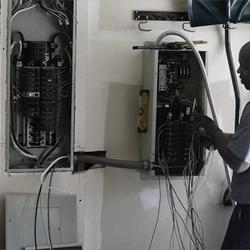Pros and Cons of a Whole‑Home Surge Protector
Wondering if you should install a whole-house surge protector? As with any purchase, it can help to outline the pros and cons of whole-home surge protection before pulling out your wallet.
In this blog, we’ll share some of the advantages and potential disadvantages of installing a surge protector in your home.
But first, let’s take a quick look at what these devices are and how they work.
Need a quote for whole-home surge protection?
Call Michael & Son today to schedule your estimate. While we’re there, we’ll provide a comprehensive inspection of your home’s electrical system and provide honest advice on the surge protection system that’s best for you.
What is a whole-home surge protector and how does it work?
A whole-home surge protection device (SPD) connects to your home’s electrical panel. It works like a filter that lets in safe electrical current but blocks dangerously high current or voltage from entering your home’s electrical system. Whenever an SPD senses an electrical surge, it reacts immediately to divert the excess current/voltage into the ground via a ground wire.
By blocking electrical surges, SPDs help prevent expensive electrical equipment in your home from burning out and, in some cases, causing electrical fires.
So what causes electrical surges in the first place? Any of the following scenarios can cause an electrical surge:
- A blackout
- Downed power lines
- Nearby lightning strikes
- Damaged wiring
- Large appliances in the house cycling on/off
While the first four of those scenarios aren’t common, the last scenario happens more than you might realize. Sometimes, when large devices with motors start up or shut down, they divert electricity to or from other appliances causing an “internal surge.”
According to NEMA (National Electrical Manufacturers Association), internal surges account for 60 to 80% of surges that occur in a home.
These internal surges can eventually destroy your electrical appliances—unless, of course, your home is protected by a whole-home surge protector.
Let’s take a deeper look at some of the advantages of whole-home surge protection.
What are the pros?
They protect your home’s appliances
Today’s modern homes have a much higher number of electronics than ever before. That said, there are likely dozens of expensive microprocessors throughout your home that need protection from electrical surges.
When installing a whole-house surge protector, you’re installing a powerful device that reacts in less than a nanosecond to turn away excess current or voltage when there is a power surge. This prevents dangerous voltage or current levels from entering your home and destroying your electronics.
Some examples of electronics that are protected when you install a surge protector include:
- Desktop computers
- Televisions
- Laptops/tablets
- Gaming equipment
- Refrigerators
- Humidifiers/HVAC systems
- Smartphones
- Washer/Dryer
- LED strips and other lighting
They protect your home’s electrical system
Not only does a whole-home SPD protect your home’s appliances, but it also protects your home’s entire electrical system.
By stopping electrical surges from ever entering your home, a whole-home surge protector ultimately protects your home’s:
- Electrical wiring
- Electrical sockets
- Electrical circuits
Keep in mind that if your home is unprotected and experiences a major power surge, there is a good chance that you may need to replace damaged electrical wiring throughout the home, which can cost as much as $8,000+.
They provide peace of mind
As we discussed above, a power surge can cause thousands of dollars in destroyed electronics on top of potential expensive damage to your home’s electrical system. And what’s worse is that most home insurance policies don’t cover damages caused by electrical surges.
Installing a whole-home surge protector prevents this expensive scenario altogether, though, giving you the ultimate peace of mind that your home and your wallet are protected.
What are the cons?
It’s an investment
Installing a surge protector can be a relatively pricey investment. Depending on the type and brand of your surge protector and your home’s electrical and wiring setup, the device, and professional installation can range anywhere from $500 to $750+.
But remember that this is a one-time investment. And you’ll want to consider the countless power surges you’re avoiding as well as the potential thousands of dollars you’re saving in electrical damage when you install a whole-home surge protector.
They don’t stop all surges
In reality, whole-house surge protectors are designed to let through surges that don’t reach a specified voltage. Every whole-home SPD comes with a specified “VPR” (voltage protection rating), which determines the maximum voltage the surge protector will let through to your home’s electrical system.
That said, a whole-home surge protector with a high VPR might let in smaller surges that can still damage electrical appliances over time.
Our suggestion? Ensure you’re installing a whole-home surge protector with a low VPR but also “layer” your home’s surge protection.
For example, get a whole-home SPD with a VPR no higher than 600V, but also make sure that you’re protecting your electrical appliances with point-of-use surge protectors or built-in surge protector outlets. That way, any excess voltage that gets past the whole-home SPD is diverted by this second layer of surge protection.
Need help from a whole-home surge protection expert?
Call Michael & Son today. Our licensed electricians have installed hundreds of whole-house surge protectors throughout the area. We provide in-home estimates as well as honest and expert advice on the type, brand, and voltage protection rating (VPR) that is best for your home’s surge protector. Backed by first-class work and 100% customer satisfaction, you can trust us to deliver the whole-home surge protection system you need at a price that works for your budget.
This blog was written on Aug 11, 2021. Any pricing information is subject to change.


